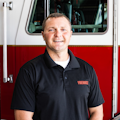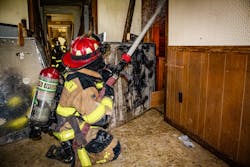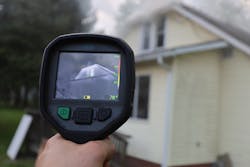When thinking of rural America, what likely comes to mind are farms, open land and dirt roads. In fact, this openness is represented in the NFPA’s definition of a “rural area.” The definition is used to represent areas that are covered by fire departments that have populations of fewer than 500 people per square mile and that present unique challenges to those who are tasked with fire suppression.
The keys to overcoming these challenges are increased knowledge of department staffing, equipping firefighters with proper equipment, and providing training that facilitates success with that staffing and equipment.
Staffing awareness
The standard for fire response to a dwelling in rural areas is substantially lower than something that’s similar in nature in a more populated area. NFPA 1720: Standard for the Organization and Deployment of Fire Suppression Operations, Emergency Medical Operations, and Special Operations to the Public by Volunteer Fire Departments sets a goal of six firefighters in no more than 13 minutes 80 percent of the time.
Many times, rural departments have areas that are farther than eight miles from the fire station. These areas only require four firefighters by the standard. The fact that the goal for response is lessened proves the known staffing difficulties that are presented in the rural fire service.
That said, rural firefighters must not fall victim to the mindset of inadequacy. Their actions still make a difference, and hanging their heads in dismay doesn’t help. The attitude of responders either works for or against a department’s response.
Firefighters must be determined to provide the best response that they can with what they have. To facilitate this, the intricacies of staffing must be understood. Those who are in command must be able to answer questions that pertain to the number of firefighters that can be expected to turn out to a fire, to how much time elapses before each apparatus leaves the station and to the limitations of your responders. Knowing these answers sets the stage for planning your response. If the typical turnout of a fire department is four firefighters during the first 15 minutes, you should develop tactical options that can be performed with that staffing.
No piece of equipment can replace the need for an adequate number of trained firefighters. That said, your equipment must complement your department’s staffing while meeting the needs of your operating environment. Placing equipment in service that isn’t congruent with staffing is a poor use of funding. Neglecting to consider the staffing needs for a piece of equipment could lead to safety concerns and subpar service to your community.
The most fundamental pieces of equipment that significantly affect your fire suppression operations are your attack line options. In the rural environment, these largely are staffed minimally at the onset of operations—despite that being when their extinguishment power is needed most.
Historically, rural departments don’t purchase and design attack packages based on what best fits the number of firefighters that they have available to use them. This most likely is because of funding/the need to purchase the most affordable hose and nozzle combinations.
A lack of available education and technical knowledge on the subject also could be a cause. However, this knowledge is readily available now from technical experts throughout the United States.
When purchasing hose and nozzle combinations, I find that it’s necessary to have a minimum flow of 150 gpm on smaller-diameter handlines. I maintain a nozzle reaction of no more than 65 lbs. Lower nozzle reaction is friendlier to fewer firefighters. I also advocate for a difference of 100 gpm for flows between our small and larger attack lines. (I believe that this makes the decision-making process easier. I also find that this difference in gpm makes it more easy to define when to use each hoseline.) Therefore, our larger attack line has a minimum flow rating of 250 gpm and less than 100 lbs. of nozzle reaction.
The rural fireground often ventures well away from paved roads yet presents with a well-involved structure. This is a reason to have a third package, which can be used as a leader line or for distant flows. I find this to be an excellent place to use a portable ground monitor that flows as much as 500 gpm. These work great for stretching up driveways that are inaccessible to fire apparatus or for reaching a well-involved fire that lacks adequate access for apparatus-mounted master streams.
Training firefighters to utilize firefighting tactics or to complete tasks with more firefighters or resources than they will have available in reality on the rural fireground won’t create lasting confidence.
All firefighters should be aware of the critical decisions that lie ahead when dispatched. This is particularly true under circumstances that could place a firefighter alone or extremely understaffed on scene for a prolonged period of time.
Stream selection is one of the critical decisions that every firefighter should be trained to make. This must be driven by the size of the fire and of the building that’s encountered. As noted above, attack lines should allow for distinct options that are designed to address escalating circumstances on the fireground.
At times, firefighters might be tempted to pull a smaller line because of a fear of running out of water. The only way to combat this perspective is to educate firefighters on the gpm that’s needed to extinguish fires of different magnitudes. If your number of responders is few, your gpm should be overwhelming to the fire. Don’t risk the need to deploy a second handline with low staffing. Don’t waste water that won’t overwhelm the heat output of the fire. Whenever it’s possible, the goal is to deliver a knockout punch—not merely hold the fire at bay until reinforcements arrive.
To ensure that decisions such as these are made properly, you must supply the necessary building blocks in incremental stages during training to all firefighters. Training must begin with the foundational knowledge and skills that are requisite to all of the fire service. Afterward, transition to how those are applied specific to the situations that the firefighters of your department likely will encounter.
All firefighters should be well-versed in how they can influence fire behavior for the good and bad via different decisions. In a perfect scenario, this involves the use of live fire training facilities.
A lack of live fire training access isn’t uncommon in rural areas. Although overcoming the logistical hurdles of building training facilities might be insurmountable, you should prepare your firefighters to make the most out of live fire training when it’s available. This begins by training without fireground stressors, such as decreased visibility, heat and the associated emotional stressors. Continual hands-on training in the firehouse, simulations and mental rehearsal in small doses keep members engaged and enhance the experience that’s gained from any live fire training evolutions. Eventually, this translates into success on actual incidents, and that success is what sustains firefighters’ excitement about their role in the mission of the fire department.
Effective fire attack
The rural fire service is presented with challenges that relate to staffing and the vastness of the area that’s served. Awareness of staffing response is the first step in providing a more effective fire attack.
Providing firefighters with the equipment that’s able to be used with the number of firefighters and resources that are available sets up crews for success. Following up with training for all firefighters—from basic skills to fireground decision-making—allows for the appropriate actions to be taken.
Joey Baxa will present “No Excuses: Tactics for the Understaffed Department” at Firehouse Expo. To register, visit firehouseexpo.com.
TICs on the Rural Fireground
Use of a thermal imaging camera (TIC) during all phases of operations on the rural fireground provides valuable information as to the location of the fire, the extent to which the fire is progressing and the layout of the structure.
Adding thermal imaging to the size-up provides a clearer understanding of the fire’s progress and of immediate exposures and severity. It also provides the ability to look ahead from the smoke-filled interior of a structure to place water where it’s needed most or to spot windows that can provide ventilation. Because firefighters often operate on the rural fireground without a designated rapid-intervention crew, the ability to identify quick egress points or doors that can be used to confine the fire provides some safety.
I recommend the TICs that sometimes are referred to as decision-making cameras. They cost more than their “situational-awareness” counterparts, but I found that they provide a more detailed image than do their counterparts and that they don’t have a tendency to “freeze” because of slow refresh rates.
About the Author

Joey Baxa
Joey Baxa has been a firefighter for 15 years. He currently holds the rank of captain with the Buckhannon, WV, Fire Department. Baxa also is an instructor with Insight Training LLC and is an adjunct instructor with West Virginia University Fire Service Extension.


